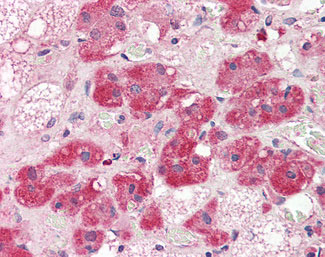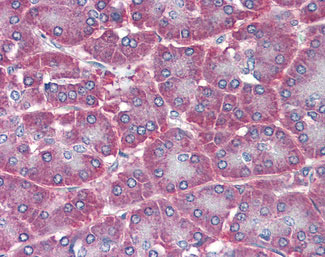NT5E / eNT / CD73 Antibody (aa27-252, clone 2B6)
Mouse Monoclonal Antibody
- SPECIFICATION
- CITATIONS
- PROTOCOLS
- BACKGROUND

Application
| WB, IHC-P, E |
|---|---|
| Primary Accession | P21589 |
| Reactivity | Human |
| Host | Mouse |
| Clonality | Monoclonal |
| Clone Names | 2B6 |
| Calculated MW | 63kDa |
| Dilution | IHC-P (10 µg/ml), WB (1:1000-1:2000), |
| Gene ID | 4907 |
|---|---|
| Other Names | 5'-nucleotidase, 5'-NT, 3.1.3.5, Ecto-5'-nucleotidase, CD73, NT5E, NT5, NTE |
| Reconstitution & Storage | Long term: -20°C; Short term: +4°C; Avoid freeze-thaw cycles. |
| Precautions | NT5E / eNT / CD73 Antibody (aa27-252, clone 2B6) is for research use only and not for use in diagnostic or therapeutic procedures. |
| Name | NT5E |
|---|---|
| Synonyms | NT5, NTE |
| Function | Catalyzes the hydrolysis of nucleotide monophosphates, releasing inorganic phosphate and the corresponding nucleoside, with AMP being the preferred substrate (PubMed:21933152, PubMed:22997138, PubMed:23142347, PubMed:24887587, PubMed:34403084). Shows a preference for ribonucleotide monophosphates over their equivalent deoxyribose forms (PubMed:34403084). Other substrates include IMP, UMP, GMP, CMP, dAMP, dCMP, dTMP, NAD and NMN (PubMed:21933152, PubMed:22997138, PubMed:23142347, PubMed:24887587, PubMed:34403084). |
| Cellular Location | Cell membrane; Lipid-anchor, GPI-anchor |

Thousands of laboratories across the world have published research that depended on the performance of antibodies from Abcepta to advance their research. Check out links to articles that cite our products in major peer-reviewed journals, organized by research category.
info@abcepta.com, and receive a free "I Love Antibodies" mug.
Provided below are standard protocols that you may find useful for product applications.
Background
Hydrolyzes extracellular nucleotides into membrane permeable nucleosides. Exhibits AMP-, NAD-, and NMN-nucleosidase activities.
References
Misumi Y.,et al.Eur. J. Biochem. 191:563-569(1990).
Otsuki T.,et al.DNA Res. 12:117-126(2005).
Mungall A.J.,et al.Nature 425:805-811(2003).
Hansen K.R.,et al.Gene 167:307-312(1995).
Zanoni L.,et al.Submitted (MAY-1998) to the EMBL/GenBank/DDBJ databases.
If you have used an Abcepta product and would like to share how it has performed, please click on the "Submit Review" button and provide the requested information. Our staff will examine and post your review and contact you if needed.
If you have any additional inquiries please email technical services at tech@abcepta.com.













 Foundational characteristics of cancer include proliferation, angiogenesis, migration, evasion of apoptosis, and cellular immortality. Find key markers for these cellular processes and antibodies to detect them.
Foundational characteristics of cancer include proliferation, angiogenesis, migration, evasion of apoptosis, and cellular immortality. Find key markers for these cellular processes and antibodies to detect them. The SUMOplot™ Analysis Program predicts and scores sumoylation sites in your protein. SUMOylation is a post-translational modification involved in various cellular processes, such as nuclear-cytosolic transport, transcriptional regulation, apoptosis, protein stability, response to stress, and progression through the cell cycle.
The SUMOplot™ Analysis Program predicts and scores sumoylation sites in your protein. SUMOylation is a post-translational modification involved in various cellular processes, such as nuclear-cytosolic transport, transcriptional regulation, apoptosis, protein stability, response to stress, and progression through the cell cycle. The Autophagy Receptor Motif Plotter predicts and scores autophagy receptor binding sites in your protein. Identifying proteins connected to this pathway is critical to understanding the role of autophagy in physiological as well as pathological processes such as development, differentiation, neurodegenerative diseases, stress, infection, and cancer.
The Autophagy Receptor Motif Plotter predicts and scores autophagy receptor binding sites in your protein. Identifying proteins connected to this pathway is critical to understanding the role of autophagy in physiological as well as pathological processes such as development, differentiation, neurodegenerative diseases, stress, infection, and cancer.



